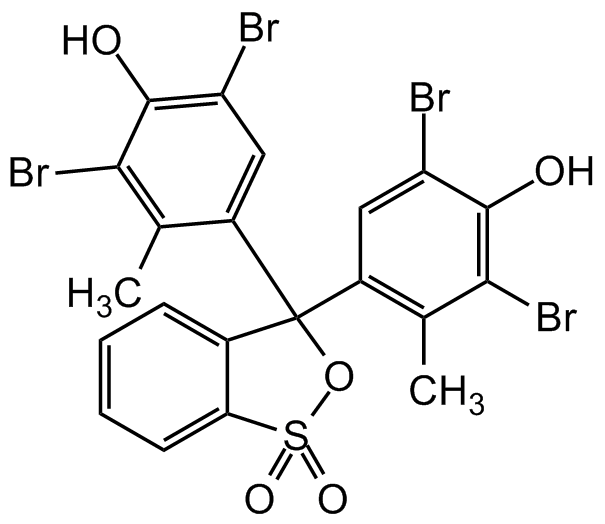Bromocresol Green
Product Code:
CDX-B0264
CDX-B0264
Regulatory Status:
RUO
RUO
Shipping:
AMBIENT
AMBIENT
Storage:
+20°C
+20°C
No additional charges, what you see is what you pay! *
| Code | Size | Price |
|---|
| CDX-B0264-G025 | 25 g | £145.00 |
Quantity:
Prices exclude any Taxes / VAT
Stay in control of your spending. These prices have no additional charges, not even shipping!
* Rare exceptions are clearly labelled (only 0.14% of items!).
* Rare exceptions are clearly labelled (only 0.14% of items!).
Multibuy discounts available! Contact us to find what you can save.
This product comes from: Switzerland.
Typical lead time: 7-10 working days.
Contact us for more accurate information.
Typical lead time: 7-10 working days.
Contact us for more accurate information.
- Further Information
- Documents
- References
- Show All
Further Information
Alternate Names/Synonyms:
3',3",5',5"-Tetrabromo-m-cresolsulfonephthalein; NSC 7817; BCG
Appearance:
Beige to yellow-brown powder.
CAS:
76-60-8
EClass:
32160000
Form (Short):
solid
Handling Advice:
Protect from light and moisture.
Hazards:
H302-H312-H315-H319-H332-H335
InChi:
InChI=1S/C21H14Br4O5S/c1-9-12(7-14(22)19(26)17(9)24)21(13-8-15(23)20(27)18(25)10(13)2)11-5-3-4-6-16(11)31(28,29)30-21/h3-8,26-27H,1-2H3
InChiKey:
FRPHFZCDPYBUAU-UHFFFAOYSA-N
Long Description:
Chemical. CAS: 76-60-8. Formula: C21H14Br4O5S. MW: 698.01. Bromocresol green (BCG) is a pH sensitive triphenylmethane dye useful in a variety of colorimetric detection technologies. BCG is used as a tracking dye for DNA agarose gel electrophoresis, in protein determinations and in charge-transfer complexation processes. In TLC BCG is used for visualization of the compounds with functional groups whose pKa is below 5.0. One major use is to measure serum albumin concentration within mammalian blood samples in possible cases of kidney failure and liver disease. In aqueous solution, bromocresol green will ionize to give the monoanionic form (yellow), that further deprotonates at higher pH to give the dianionic form (blue). Visual transition interval: pH 3.8 (yellow) - 5.4 (blue). UV-Visible (lambdamax): 423 nm, 444 nm, 617 nm. Bromocresol green is also an inhibitor of prostaglandin uptake that blocks the immediate rise in intracellular immunoreactive PGE2 following treatment with 16,16-dimethyl-PGE2. Bromocresol green prevents the stimulatory effect of 16,16-dimethyl-PGE on cell proliferation, adhesion, migration and invasion and on HIF-1alpha expression and activity. Additional applications include use in sol-gel matrices and the detection of ammonia.
MDL:
MFCD00005874
Molecular Formula:
C21H14Br4O5S
Molecular Weight:
698.01
Package Type:
Vial
Product Description:
Bromocresol green (BCG) is a pH sensitive triphenylmethane dye useful in a variety of colorimetric detection technologies. BCG is used as a tracking dye for DNA agarose gel electrophoresis, in protein determinations and in charge-transfer complexation processes. In TLC BCG is used for visualization of the compounds with functional groups whose pKa is below 5.0. One major use is to measure serum albumin concentration within mammalian blood samples in possible cases of kidney failure and liver disease. In aqueous solution, bromocresol green will ionize to give the monoanionic form (yellow), that further deprotonates at higher pH to give the dianionic form (blue). Visual transition interval: pH 3.8 (yellow) - 5.4 (blue). UV-Visible (lambdamax): 423 nm, 444 nm, 617 nm. Bromocresol green is also an inhibitor of prostaglandin uptake that blocks the immediate rise in intracellular immunoreactive PGE2 following treatment with 16,16-dimethyl-PGE2. Bromocresol green prevents the stimulatory effect of 16,16-dimethyl-PGE on cell proliferation, adhesion, migration and invasion and on HIF-1alpha expression and activity. Additional applications include use in sol-gel matrices and the detection of ammonia.
Purity:
>95% (Dye content)
SMILES:
O=S1(C2=CC=CC=C2C(C3=CC(Br)=C(O)C(Br)=C3C)(C4=C(C)C(Br)=C(O)C(Br)=C4)O1)=O
Solubility Chemicals:
Soluble in ethanol (30mg/ml).
Transportation:
Non-hazardous
UNSPSC Category:
Fluorescent Reagents
UNSPSC Number:
41105331
Use & Stability:
Stable for at least 2 years after receipt when stored at RT.
Documents
References
(1) P.G. Hill; Ann. Clin. Biochem. 22, 565 (1985) | (2) F.R. Zaggout; J. Disp. Sci. Technol. 26, 757 (2005) | (3) R.W. Sabnis; Handbook of Acid-Base Indicators (2008) | (4) A. Madrigal-Martinez, et al.; Int. J. Biochem. Cell Biol. 59, 52 (2015)



